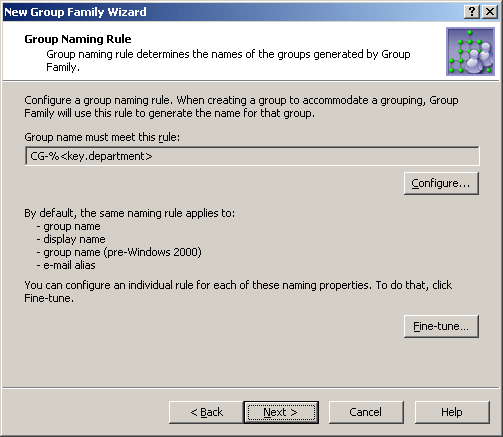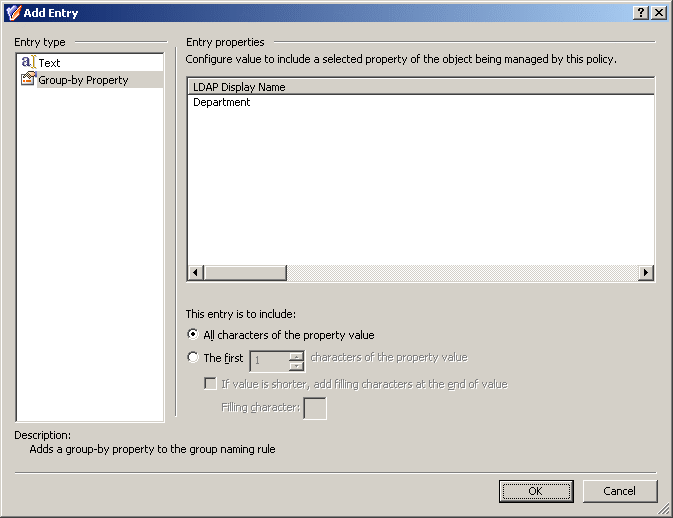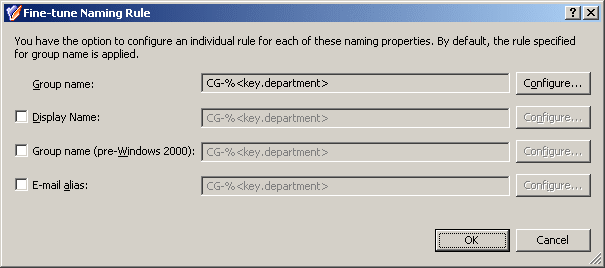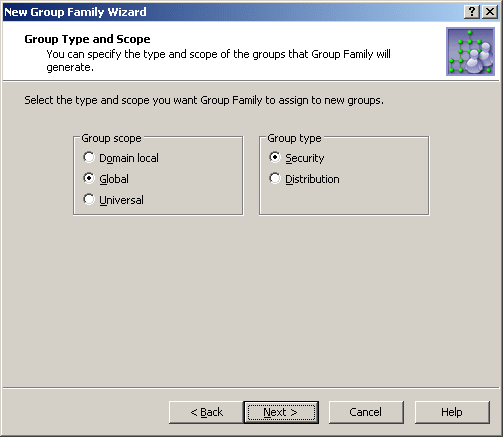Group naming rule
On the next page of the wizard, you can view or modify the group naming rules used by the Group Family.
When creating a new group, the Group Family generates the group naming properties such as Group name, Display name, Group name (pre-Windows 2000) and, optionally, E-mail alias. Unless otherwise specified, the Group Family uses a certain default rule to generate those properties based on the values of the group-by properties.
Figure 100: Group naming rule

By default, the Group Family generates the group naming properties based on the following syntax: CG-%<key.property1>-%<key.property2>... In this syntax, CG is the abbreviation for Controlled Group, whereas each of the %<...> entries is used to represent a value of a certain group-by property. When creating a group for a given grouping, the Group Family substitutes the grouping-specific value of the group-by property for the entry containing the name of that property. For example, with a grouping identified by the Operations value of the Department property, the group name is set to CG-Operations. With two group-by properties, such as Department and City, an example of the group name could be CG-Operations-London.
You can modify the group naming rule by clicking the Configure button. This displays the Configure Value dialog box, discussed earlier in this document (see How to configure a Property Generation and Validation policy). You can use that dialog box to set up a value for the ‘name’ must be condition, in the same way as you do when configuring a Property Generation and Validation policy.
A value is a concatenation of one or more entries. The Configure Value dialog box provides the Add, Edit, and Remove buttons for managing the list of entries. Clicking Add displays the Add Entry window.
In the Add Entry window, you can select the type of the entry to add, and then configure the entry. The available types of entries are as follows:
- Text Adds a text string to the group naming rule.
- Group-by Property Adds a group-by property or a part of a group-by property to the group naming rule.
To add a text string, you simply type a text in Add Entry window. The next subsection elaborates on the Group-by Property entry.
Entry type: Group-by Property
When you select Group-by Property under Entry type in the Add Entry window, the Entry properties area looks similar to the following figure.
Figure 101: Group-by property

Using the Group-by Property entry type, you can add an entry representing a value (or a part of a value) of a group-by property. Select a group-by property from the list, and then do one of the following:
- If you want the entry to include the entire value of the property, click All characters of the property value.
- If you want the entry to include a part of the property value, click The first, and specify the number of characters to include in the entry.
If you choose the second option, you can select the If value is shorter, add filling characters at the end of value check box, and type a character in the Filling character box. This character will fill the missing characters in the value of the property if the value is shorter than specified in the box next to The first. For example, if you specify The first 12 characters and enter 0 as the filling character, the Accounting property value results in the Accounting00 entry.
When you are done configuring an entry, click OK to close the Add Entry window. The entry is added to the Configure Value dialog box. When you have completed the list of entries, click OK to close that dialog box. Note that the naming rule must include an entry for each of the group-by properties.
Separate rule for each naming property
By default, the same rule applies to these naming properties:
- Group name
- Group name (pre-Windows 2000)
- Group display name
- E-mail alias (if the Group Family is configured to create mail-enabled groups, as described later in this chapter)
You have the option to configure an individual rule for each of these naming properties. To do so, click Fine-tune on the Group Naming Rule page. This displays a window where you can select a naming property and configure a rule for that property the same way as you do for Group name. The window looks similar to the following figure.
Figure 102: Fine-tune naming rule

You may need to configure a separate rule for a certain property, considering restrictions imposed on that property. For example, Group name (pre-Windows 2000) must be less than 20 characters. In order to meet this requirement, select the Group name (pre-Windows 2000) check box and click Configure to set up an appropriate rule. When configuring entries to include group-by properties, limit the number of characters in each entry by using the option The first in the Add Entry window.
Group type and scope
On the next page, you can specify the group scope and group type you want to be assigned to the groups generated by the Group Family.
Figure 103: Group type and scope

Available are the standard options for the group scope and group type. The Group Family creates groups of the scope and type you select.




